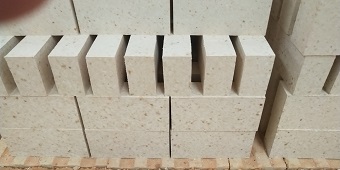Slag resistance of high alumina refractory
Compared with clay refractories, high-alumina refractories are characterized by high refractoriness and softening temperature under load. With the increase of the mass fraction of Al2O3, the slag resistance performance is significantly improved.
1. Refractoriness. The refractoriness of high alumina refractory fluctuates widely, generally 1770-2000 ℃, which is mainly affected by the mass fraction of Al2O3, and increases with the increase of the mass fraction of Al2O3 in the product. At the same time, the refractoriness is also affected by the mass fraction and type of impurities, which is related to the mineral phase structure of the product.
2. Load softening temperature. The softening onset temperature of high alumina products is higher than 1400℃ and increases with the increase of Al2O3 mass fraction. For products whose mass fraction of Al2O3 is less than 71.8%, the softening temperature under load depends on the quantity ratio of mullite and liquid phase, and increases with the increase of mullite quantity. The amount and nature of the liquid phase have a significant effect on the softening point under load. When the mass fraction of Al2O3 is between 71.8% and 90%, it is a mullite and corundum product. With the increase of the mass fraction of Al2O3, the number of glass phases is basically unchanged. Although the corundum increases, the mullite decreases, so the load softens. The temperature increase was not significant. After the mass fraction of Al2O3 exceeds 90%, with the increase of the mass fraction of Al2O3, the number of glass phases decreases, and the softening temperature under load increases significantly, from 1630 °C when the mass fraction of Al2O3 is 90% to 1900 when the mass fraction of Al2O3 is 100%. °C.

3. Thermal conductivity. High alumina refractory has higher thermal conductivity than clay products. The reason is that there are few glass phases with low thermal conductivity in high aluminum products, while the mass fraction of mullite and corundum crystals with better thermal conductivity increases, which improves the thermal conductivity of products.
4. Thermal shock resistance. The thermal shock resistance of high alumina refractory products is between clay products and siliceous products, and the 850 ℃ water cooling cycle is only 3-5 times. This is mainly because the linear expansion of corundum is higher than that of mullite, and there is no crystal transformation. Improving the thermal shock resistance of high aluminum products is an important issue to be solved urgently. At present, the thermal shock resistance of the product is improved by improving the particle structure of the product, reducing the mass fraction of fine particles, and increasing the critical particle size and reasonable gradation of the clinker. The thermal shock resistance of high-alumina bricks with a reasonable structure can be improved to more than 30 times of the above-mentioned cold and heat cycles.
5. Slag resistance. The main component of high alumina refractory bricks is Al2O3. Al2O3 is an amphoteric oxide. When the product is a mullite-corundum structure, the slag resistance increases with the increase of the mass fraction of Al2O3 and increases with the decrease of the liquid phase. High-alumina refractory products can resist not only the erosion of acid slag but also the effect of alkaline slag. However, the ability of resisting alkaline slag is not as good as that of magnesia material, but it is better than that of clay material, and it increases with the increase of the mass fraction of mullite and corundum.
In addition, the slag resistance of high alumina refractories is also related to the stability of the product in slag. For example, in the balance system of CaO-FeO-Al2O3-SiO2, the stability of corundum products is poor, while in the balance system of CaO-MgO-Al2O3-SiO2 without FeO, the stability of corundum and mullite-corundum products Significant improvement, improved slag resistance. After high-pressure molding and high-temperature firing, the porosity of the product is reduced, which can effectively improve the slag resistance of the product.
-

Silicate fire brick
Silicon thermal insulation refractory brick refers to the thermal insulation refractory products made of silica as the main raw material, with a SiO2 content of no less than 91%. In addition to the heat insulation perfor··· -

silica bricks manufacturing process
1.1 Determination of raw material ratio and particle compositionThe raw materials for making silica bricks are silica and waste bricks containing more than 96% SiO2, in addition to lime, mineralizers and organic binders.··· -

Alumina hollow ball bricks
Alumina hollow ball bricks are made of alumina hollow balls and alumina powder as the main raw materials, combined with other binders, and fired at a high temperature of 1750 degrees. It belongs to a kind of ultra-high t··· -

Anti-stripping high alumina brick for cement kiln
Anti-stripping high alumina bricks are made of high alumina bauxite clinker, mullite, kyanite, zircon sand, and binder first through granulation and powdering processes, mixed in a certain proportion, then pressed into s···

